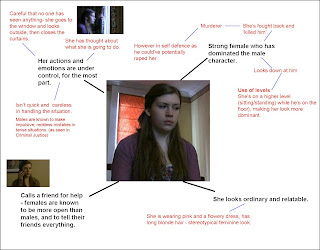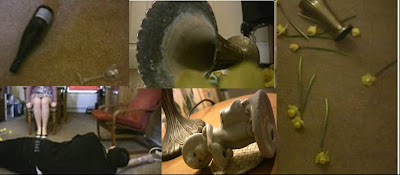The project is over! This Blog is now closed!
Thursday, April 1, 2010
Sunday, March 28, 2010
7) Looking back at your preliminary task, what do you feel you have learnt in the progression from it to the full product?
FEEDBACK:
Feedback for our prelim was by teachers and other media students so the technical aspects were focused on (as the aim of seamless continuity was more technical).
Posted by LATYMERMEDIA at 2:18 AM 0 comments
Labels: Evaluation, Main Task, Question 7
6) What have you learnt about technologies from the process of constructing this project?
Our final shot is the only shot with dialogue, so we needed to remember to put the microphone on when shooting this shot.
During post production I was able to develop knowledge and skills of the non linear editing software we used, 'Adobe Premier Pro':
I learnt how to alter the speed and duration of a shot. Like this wide master shot:
Posted by LATYMERMEDIA at 2:17 AM 0 comments
Labels: Evaluation, Main Task, Question 6
5) How did you attract/ address your audience?
Posted by LATYMERMEDIA at 2:16 AM 0 comments
Labels: Evaluation, Main Task, Question 5
4) Who would be the audience for your media product?
The feedback implies that the audience is broader than we intended, in terms of age.
Posted by LATYMERMEDIA at 2:16 AM 0 comments
Labels: Evaluation, Main Task, Question 4
3) What kind of media institution might distribute your media product and why?
Posted by LATYMERMEDIA at 2:15 AM 0 comments
Labels: Evaluation, Main Task, Question 3
Friday, March 26, 2010
2) How does your media product represent particular social groups?
● With the use of Strauss’ theory of binary opposites, ‘Dawn’ represents gender by going against the stereotype, particularly in the thriller genre, as Dawn is the female murderer and 'John' is the male victim in the opening sequence.

Posted by LATYMERMEDIA at 6:21 AM 0 comments
Labels: Evaluation, Main Task, Question 2
1) In what ways does your media product use, develop or challenge forms and conventions of real media products?

Inspired by 'Eternal Sushine of the Spotless Mind' (2004, Gondry)
Posted by LATYMERMEDIA at 6:00 AM 0 comments
Labels: Evaluation, Main Task, Question 1
Friday, March 19, 2010
Finished Editing
After 3 shoots and weeks of editing we have finished our sequence. Here's how it has developed:
1st Test Shoot:
2nd Test Shoot:
Final Sequence:
Posted by LATYMERMEDIA at 1:52 AM 0 comments
Labels: Production
Friday, March 12, 2010
Arty Style influences
Some clips that I think could help us carry out our arty style and with editing techniques:
Eternal Sunshine of the spotless mind (Gondry, 2004)
(watch from 0:50 when the titles start, i like the sequence at 3:25)
Also Insomnia (Nolan, 2002)
I like the really close up shots of the blood on the fabric, we could do something similar...
Posted by LATYMERMEDIA at 2:46 AM 0 comments
Labels: Production, Research
Friday, March 5, 2010
Final Shoot Reflections
I think we got all the shots we needed on our final shoot. We finished early which was worrying so we redid some shots just incase. Hopefully we wont have to reshoot.
Posted by LATYMERMEDIA at 2:47 AM 0 comments
Labels: Production
Wednesday, February 10, 2010
Test Shoot 1 : Reflections
Our first test shoot went well. We did all the shots we'd planned to do with time to spare. At the end we improvised some shots. We filled in the shot logs so editing will be easier when we get back to school.
Posted by LATYMERMEDIA at 1:37 AM 0 comments
Labels: Production
Tuesday, January 26, 2010
Monday, January 25, 2010
Group meeting 2: Reflections
I am very pleased with the group meetings so far, I think we've progressed a lot in terms of developing our idea for the opening sequence. We're all constantly coming up with ideas and communicating them within the group is quick and easy.
Posted by LATYMERMEDIA at 1:16 PM 0 comments
Labels: Planning
Friday, January 22, 2010
Group meeting 1: Reflections
I thought our first group meeting was successful- we agreed on a great idea and established similar styles, programmes and films as possible influences. I am looking forward to seeing how this idea develops and working on it with my group ;)
Posted by LATYMERMEDIA at 1:40 PM 0 comments
Labels: Planning
Thursday, January 21, 2010
Clips of influences
The idea of someone seeing things that aren't really there was influenced by the hallway scene from 'The Shining' (Kubrick, 1980):
The idea of a character witnessing a murder comes from Shaft (Singleton, 2000)
Posted by LATYMERMEDIA at 1:15 PM 0 comments
Labels: Research
Research
Posted by LATYMERMEDIA at 12:10 PM 0 comments
Labels: Initial Ideas, Planning, Research
Wednesday, January 20, 2010
COURSEWORK
The coursework project starts here. From now, all work posted will be associated with the main coursework task. The link to the group coursework blog is in the links list.
Posted by LATYMERMEDIA at 1:07 AM 0 comments
Labels: Main Task











































